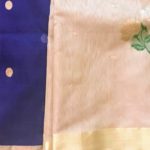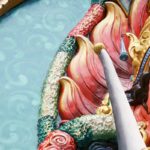Creation Myths of the Kanchipuram Weavers
There are four castes involved in weaving in Kanchipuram: the Devangas, Saurashtras, the Sengunthar and the Padma Saalis. Each have a different lineage and interesting stories around their arrival into Kanchipuram. The Saurashtra migration is well known because they populated many of the weaving centres in Tamilnadu including Madurai, Thanjavur and Kanchipuram.
The Devangas take their name from Deva-angu or clothes for the devas (gods). They came from different parts of the South including Tamilnadu and Karnataka.
Here we focus on the creation myths of two large groups/castes of weavers. The Padma Saalis and the Sengunthars.
The way of the red dagger: The Sengunthars
The Sengunthars were also called Kai Kolars. Sengu means red dagger. Unthar means carrier. This warrior community fought for the Chola kings. Not wanting to fight for non-Tamil kings, they took to weaving in the 13-14th centuries. They claim descent from Virabahu, one of the lieutenants of Lord Muruga. When Lord Shiva opened his third eye to create the spark that would become Lord Muruga, Parvathi ran away in fear, scattering nine gems from her anklet. Out of these nine gems came nine strongmen, Virabahu among them. The Sengunthars are descendents of Virabahu and celebrate the “Sura Samharam” or killing of the demon festival with gusto. Read more about it here.
The Padma Saalis
It the beginning of time. It was the end of time. When one yuga was ending and another, beginning. There was god. Well, gods and goddesses actually. All of them clad in, well, nothing. One day they gathered in a celestial sabhai (sabha) to discuss how to overcome their nudity. They decided to appeal to Markandeya, who had been granted a boon of immortality by Lord Shiva. When they approached him, he was engrossed in conducting a putra kameshti yagam or fire sacrifice for the birth of a son. Through his prayers and mantras, Markandeya conceived of a being whose figure arose from the flames of the homa kundam or havan. He had the likeness (amaippu) of Narayana. His handsome body was adorned with a variety of ayuthams or weapons. His skin was glowing. His hair flashed like the navaratna gems. The whole effect was like the radiance of a thousand suns (kodi surya prakasham).
The Mythical Being
Created from the power of five mantras, this being, called Bhava Narayana came to be called as pancha bhuthi or one who is born of the five elements. He possesses a secret weapon, what we call a killer app in these days. He knows how to weave cloth and thus can solve the problem and save the honour of the gods and goddesses who are appealing to him. Awestruck by the force of his knowledge (jnanam udaiyam) the divine gathering asks how he proposes to weave the clothes that will clad their bodies. In response, Bhava Narayana creates the loom from parts of his body. His head becomes the cloth beam. His arm, the vertical pillars that hold the weaving frame together. His chest becomes the weaving heald frame or heddles, that allows the shuttles to pass through. You get the picture. His spine forms the overhead horizontal bar of the loom frame. From his legs and feet come the foot pedals or treadles. Heddles and treadles– the head and foot of the weaving frame.
Bhava Narayana turns to his progenitor, Narayana– Lord Vishnu for the weaving thread. He takes the fibres from the lotus rising up from the navel of Lord Vishnu (undhi kamalam). Markandeya himself winds this padma nul or lotus thread around his crossed knees and gives it to his son, Bhava Narayana. With the help of a secret shambavi mantram given to him by Lord Brahma, Bhava Narayana proceeds to weave this lotus fibre cloth that is as white and shimmering as Vishnu’s lotus.
Each god gets a customized cloth. Lord Vishnu gets the pithambaram, Garuda gets a garuda-dhvajam or flag. The saalvai or cloth of honour for Brahma. Creeper-bordered cloth for Rati and Manmatha. And so on for the 33 crore gods. The entire assembly is now illuminated by this radiant lotus fibre cloth.
This creation myth is recounted by the Padma Saaliyars.
Source: The book, “We Who Wove with Lotus Thread” by Aarti Kawlra.




